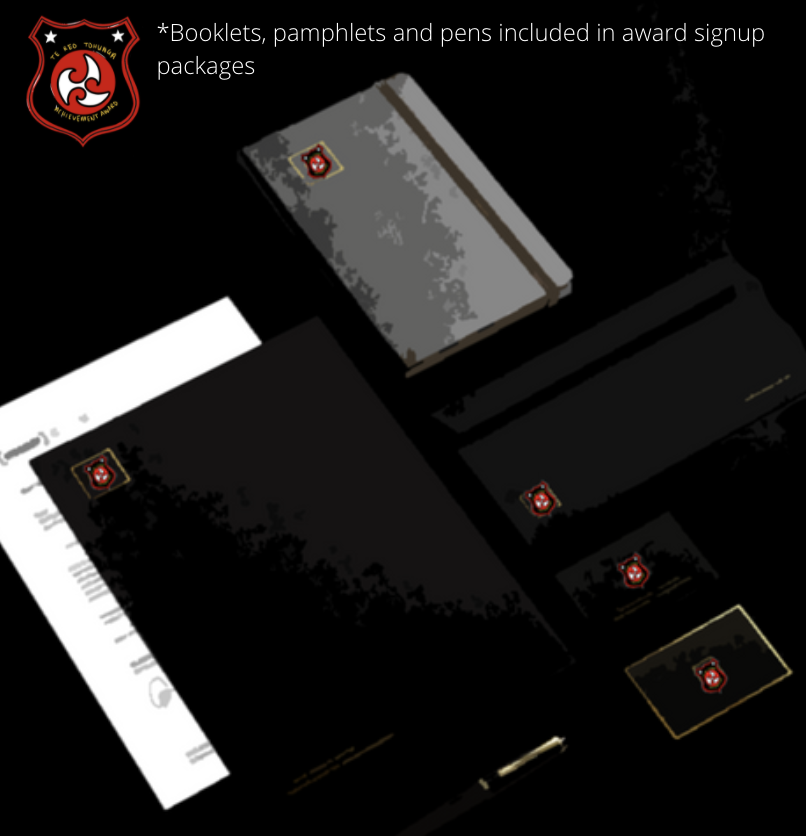DES230 Healthy Communities - Te Reo Tohunga Achievement Award
- Emily Huang

- Oct 29, 2020
- 6 min read
Updated: Oct 30, 2020
Team members: Emma Tiplady, Phillip Kosektatino
INTRODUCTION
Our initial challenge was Designing for Healthy Communities and from this, we focused on cultural diversity in New Zealand. Cultural Diversity refers to "the existence of a variety of cultural or ethnic groups within a society" (Oxford Languages, 2020), with a particular focus on the native language and culture of New Zealand. Our design process involved various tools and methods such as an ecosystem map, problem space map, primary and secondary research, ideation, value proposition and a blueprint. This design process successfully led us to our design strategy for the Te Reo Tohunga Achievement Award. The objective was to create a service to normalise further Te Reo and the Maori culture in New Zealand to result in a more cohesive and holistic Aotearoa.
DESIGN PROCESS
The design process was crucial in developing our design strategy over the six weeks, and it allowed us to follow step-by-step design tools that would influence the following week.
Our design process began with the ecosystem's map by conducting background research on cultural diversity in Aotearoa and analysing The Maori Language Movement (Reo Maori, 2020), a peaceful protest since 1972 to help keep the Maori culture alive through songs, dances, waiata's and interactive activities within the communities of Aotearoa. As a result, we were able to define our problem, prevent acculturation in the Maori community from western society, focus on the Maori language and its everyday use.
We were then able to dive deeper into the problem with the Maori language in New Zealand by examining the data, technologies, products, experiences, systems and implications through the problem space map (Amaral, 2020). We came across a trend that New Zealanders who were not ethnically Maori had little to no motivation to learn or speak the language as they felt awkward. Implications associated with this were that Teo Reo education diminishes as a child progresses into intermediate and high school in New Zealand.
The information we gained from the problem space map led to conducting further primary and secondary research on Te Reo Maori in New Zealand through interviews, a service safari and secondary research via websites and databases (Amaral, W8 Studio slides & recording, 2020). This stage was highly significant when developing our design strategy as it gave us a better understanding of specific issues and challenges individuals faced. A common theme that we spotted throughout the interviews was that people didn't feel like they had the knowledge and confidence in speaking Te Reo Maori in their day to day lives, as they didn't have the education towards Te Reo.
From all the research gained, we were now able to complete the ideation phase (Amaral, W9 Studio slides & recording, 2020), which helped us brainstorm, ideate, evaluate and produce design strategies. Our top three strategies included celebrations/events to celebrate the Maori culture, educational Tv shows with subtitles and a Te Reo Maori Award for high school students. We evaluated these ideas by comparing them based on impact, feasibility, and overall service's strength. From this, we reduced our ideas into two strategy concepts of a Te Reo Subtitles setting and an award for knowledge towards Te Reo Maori. Out of the two strategies, we had not yet decided on the best one to help normalise Te Reo Maori in New Zealand. We continued with our design process with both of these strategy concepts in mind.
The next step was the Value Proposition canvas (Amaral, W9 Studio slides & recording, 2020), which helped to examine the strategy and
community into different aspects. By filling in this canvas, we quickly realised that an award for knowledge towards Te Reo Maori had more significant impacts and long term benefits towards the New Zealand community. However, we could also incorporate the TV subtitles strategy into the award, further enhancing the overall design strategy.
The final step in the design process was the blueprint canvas, which consisted of five different aspects; physical evidence, journey map, front end, back end, and support (Amaral, W10 Studio Slides, 2020). From the blueprint, we were able to consider all elements that helped lock in our final design strategy of preventing acculturation in the Maori community from western society, focusing on the Maori language and its everyday use in society.
DESIGN STRATEGY
Our final design strategy is the Te Reo Tohunga Achievement Award to normalise Te Reo Maori in New Zealanders' everyday lives. This award targets students between the years 11-13, as, from our research, we discovered that individuals found little presence of Te Reo Maori throughout their time at high school. New Zealand youth can make a significant difference to the future and to other generations, which is why we have chosen them as our target users. The nationally recognised award will take a year to complete and students are required to tick off specific tasks with assistance from teachers. As a result, the award will be striving towards preventing acculturation in the Maori community from a western society, focusing on the Maori language and its everyday use.
We will be working directly alongside the Ministry of Education (MOE) to help nationally establish and promote the award to schools all across the country and gain funding and grants. The MOE will certify the Te Reo Tohunga Achievement Award as a high qualification award similar to subject endorsements, which will be reflected on their NZQA Record of Achievement (NZQA, 2020) and future CV's. This award will create a systematic approach to deconstruct the uncomfortable culture around speaking Te Reo Maori.
The award will take a year to complete, where schools, teachers, students and families will be informed and educated on the Te Reo Tohunga Achievement Award at the start of the year. The award's initial stage is to provide schools with the information and access to the award through the Ministry of Education. Following this, guest speakers will attend schools with presentations and the information required to sign up in person or online. The guest speakers will also hand out promotional products such as booklets, pens and task sheets.
Students will then be able to start completing the award by doing specific tasks designed to improve their use of Te Reo through their everyday lives by listening, hearing, speaking, immersing and experiencing the Maori culture first hand. We have created one particular task: the TV subtitles task designed to enhance Te Reo Maori through listening, interpreting words, phrases, and sentences.
Students must watch at least eight episodes of a single TV show to complete the task, using subtitles in Te Reo and filling out the task sheet with a teacher signing it off. Students can access the Te Reo Subtitles through a software download on their laptops, translating the English subtitles directly into Te Reo. This is a tool designed by the Te Reo Tohanga Award, which is even accessible after graduating high school as it is a software download. Other tasks include attending a service such as a Marae, Kapa Haka performance, General Te Reo Maori Quiz, a Mihi, a Speech dialogue and a personal interaction with a fluent Maori speaker. Once they have completed the set amount of tasks, then the next step is to get the award certified by a registered teacher.
The final step of the Te Reo Tohunga Achievement Award is when successful students will be invited to an Awards ceremony to celebrate their efforts. Students will be presented with a certificate and badge to recognise their achievement in being apart of normalising Te Reo and Maori culture in Aotearoa.
IMPACT
Our design strategy of the Te Reo Tohunga Achievement Award is heading towards preventing the Maori community's acculturation from western society, focusing on the Maori language and its everyday use. The award provides New Zealand's a chance to be more educated and feeling more comfortable with speaking Te Reo Maori in their daily lives. Through our listening, hearing, verbal and interaction tasks, students can directly immerse themselves into the Maori culture and Te Reo language, which will significantly benefit the newly learned knowledge sticking in the long term. Students' skills can be incorporated into their everyday lives after high school, with the confidence to speak and understand the language. As a result, the Te Reo Tohunga Achievement Award will help decompose the uncomfortable and awkward culture towards Teo Reo in a systematic approach, resulting in healthier New Zealand communities.
CONCLUSION
In conclusion, we have successfully worked towards healthier communities in New Zealand by focusing on preventing the acculturation in the Maori community from western society, focusing on the Maori language and its everyday use. We could develop the Te Reo Tohunga Achievement Award through the design process of implementing the ecosystems map, problem space map, primary and secondary research, ideating, value proposition, and a blueprint. The award targets senior high school students between years 11-13. The aim is to normalise using the Te Reo language in their daily lives through listening, reading, speaking, experiencing and immersing themselves directly into the Maori culture. The Te Reo Tohunga Achievement Award will be a positive step towards a more holistic and culturally accepting Aotearoa.
Works Sited:
Amaral, C. (2020). W10 Studio Slides. Auckland, New Zealand.
Amaral, C. (2020). W8 Studio slides & recording. Auckland, New Zealand.
Amaral, C. (2020). W9 Studio slides 7 recording. Auckland, New Zealand.
Amaral, C. (2020). Week 7 Studio slides & recording. Auckland, New Zealand.
NZQA. (2020). NCEA endorsements. Retrieved from NZQA: https://www.nzqa.govt.nz/ncea/understanding-ncea/how-ncea-works/endorsements/
Oxford Languages. (2020, October). Cultural diversity definition. Retrieved from Google: https://www.google.com/search?rlz=1C5CHFA_enNZ890NZ894&biw=1440&bih=764&ei=omeaX4SGJp3Xz7sPyaO3qAM&q=cultural+diversity+idefinition&oq=cultural+diversity+idefinition&gs_lcp=CgZwc3ktYWIQAzIMCAAQyQMQDRBGEPkBMgQIABANMgQIABANMgQIABANMgQIABANMgQIABANMgQIABANMg
Reo Maori. (2020). Maori Language Movement. Retrieved from Tuku Reo Maori: https://tuku.reomaori.co.nz/
























Comments